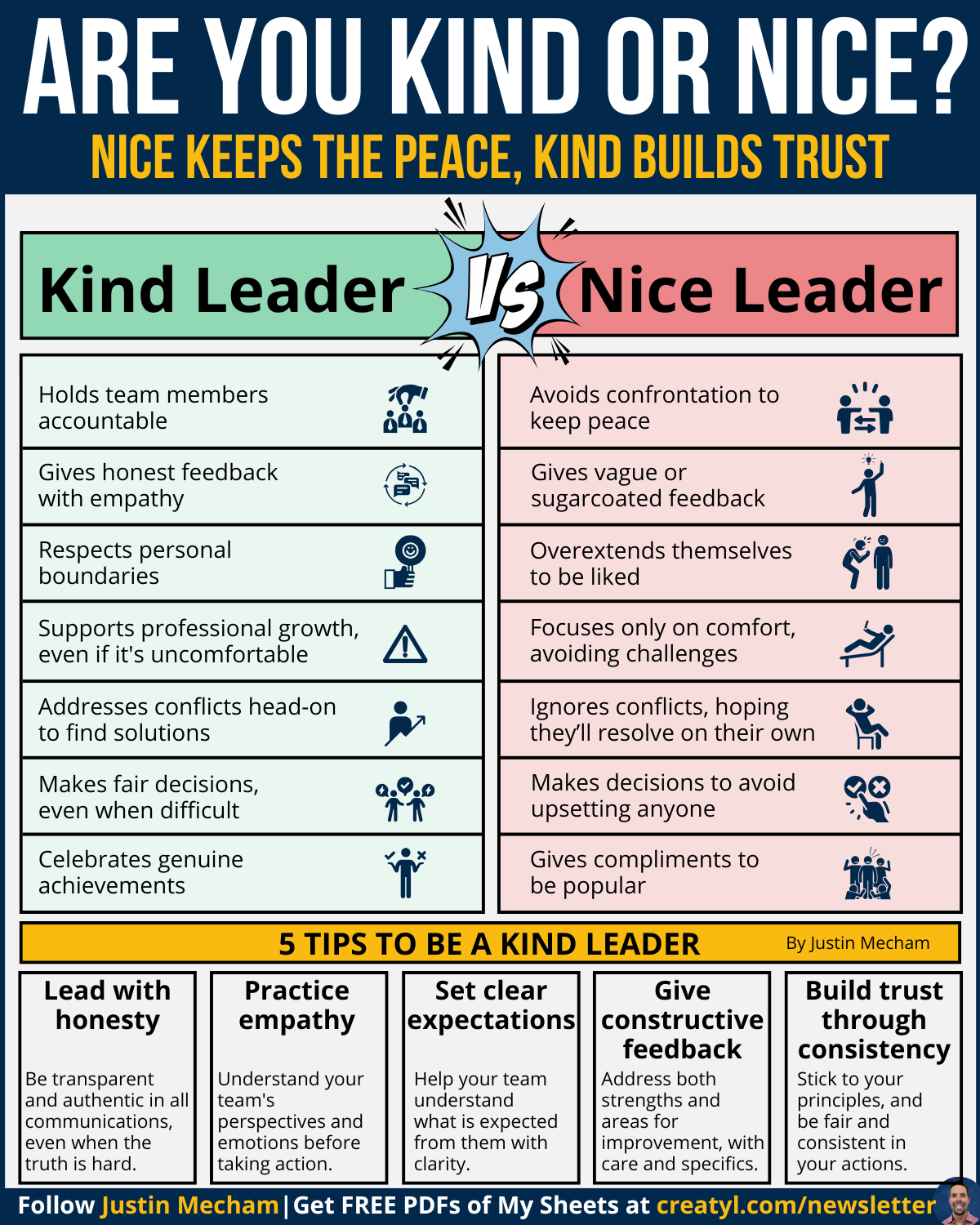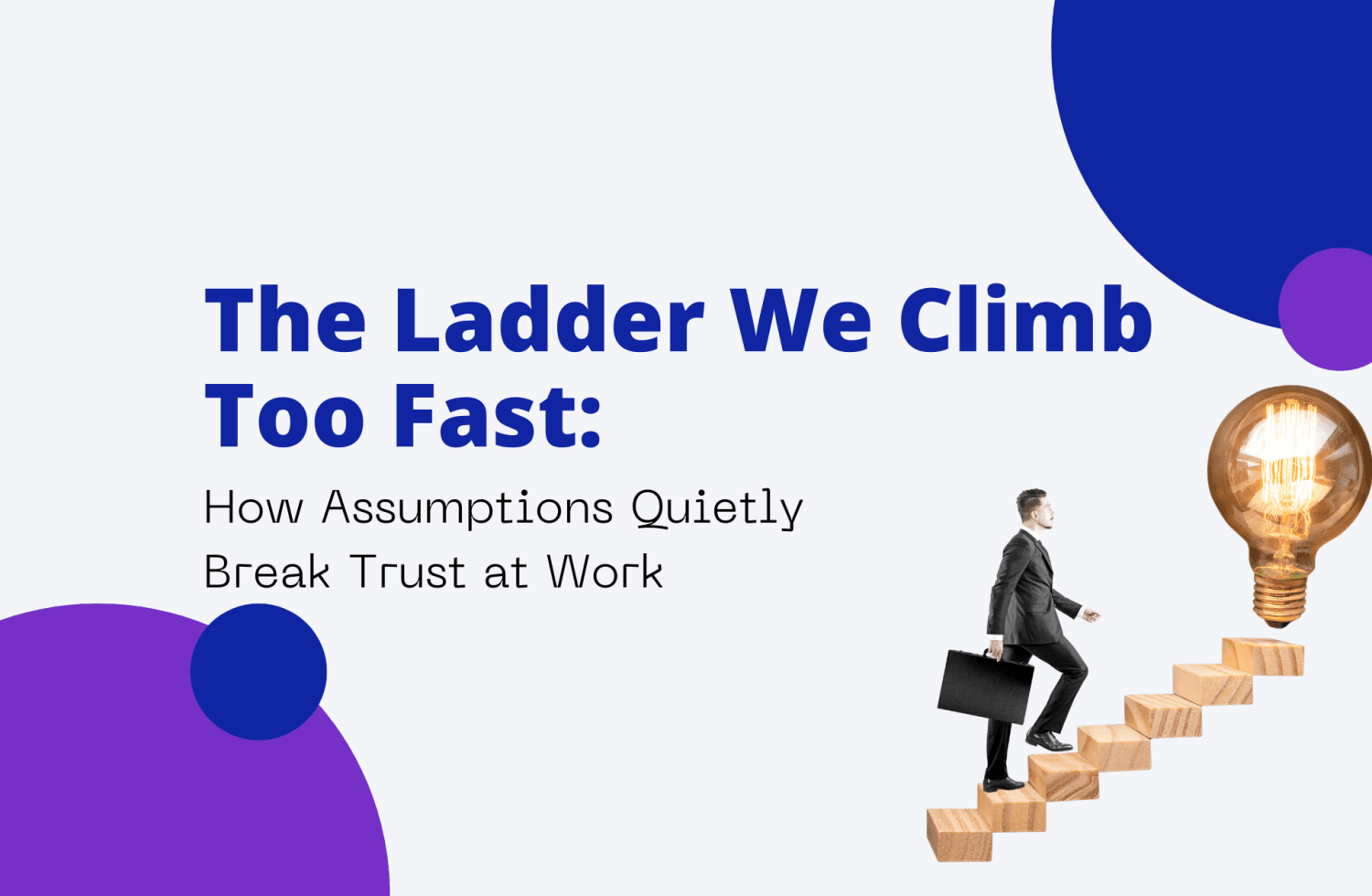Click Here to Download the PDF
We’ve all worked for a “nice” leader.
They smile in meetings.
They say things like “no worries” and “great job” even when something went wrong.
They mean well.
But they rarely say what needs to be said.
And here’s the hard part—
Most of us have been that leader, too.
Because being nice feels safe.
You keep the peace. You avoid tension. You think you’re creating a supportive environment.
But if you’re always choosing peace over progress, you’re not leading.
You’re stalling.
Kind leadership is different.
It’s not softer. It’s stronger.
The best leaders don’t aim to be liked.
They aim to be trusted.
Why “Nice” Leadership Looks Good but Fails Quietly
Let’s be real: being nice is easy.
You avoid confrontation. You sugarcoat feedback. You say yes even when you shouldn’t.
No one gets mad. Everyone smiles. It feels like things are working.
But over time, cracks form—because people don’t grow through comfort.
They grow through clarity.
Nice leaders tend to:
- Choose short-term peace over long-term truth
- Avoid giving real feedback because it feels awkward
- Say yes too often just to stay in everyone’s good graces
- Hope problems will resolve themselves without confrontation
- Give vague compliments instead of recognizing actual achievement
And at first, it works.
Your team seems happy. No one’s upset.
But then people start second-guessing your words.
They don’t know where they stand.
They stop improving, not because they don’t want to—but because they never hear the truth.
Nice leaders protect feelings in the moment.
But they erode trust over time.
What Kind Leadership Actually Looks Like in Practice
Kindness doesn’t mean sugarcoating.
It doesn’t mean being soft, agreeable, or passive.
Kind leaders care deeply about their people.
And they show that care by telling the truth—even when it’s uncomfortable.
They don’t give out false praise.
They don’t pretend everything is fine.
They don’t hide behind passive phrases like “maybe just think about…” when what they really mean is “this needs to change.”
Instead, they:
- Give honest, respectful feedback that helps people grow
- Hold high standards and believe others can meet them
- Set clear expectations—and revisit them often
- Address conflict directly instead of tiptoeing around it
- Make decisions based on what’s right, not what’s easy
- Follow through on their word so people know they’re reliable
Kind leaders earn their team’s trust—because their actions match their intentions.
They don’t avoid hard conversations.
They make those conversations easier to have.
Real Workplace Example: Turning Niceness into Kindness
Here’s a real story from a team I worked with as a consultant—and how shifting from “nice” to “kind” completely changed their culture and performance.
A mid-sized marketing team at a startup was constantly behind on deliverables.
The team lead—who genuinely cared about their people—didn’t want to seem demanding. So when deadlines slipped, they stayed quiet.
They reassured everyone that things were okay. They even picked up the slack themselves, staying late and editing campaigns to make up the difference.
But the silence wasn’t kindness.
It was avoidance.
And while the team liked their leader, they had no idea they were underperforming.
They thought things were fine—until tensions boiled over in private Slack threads and side conversations.
The leader was quietly frustrated and overwhelmed.
They felt they couldn’t say anything without coming across as too harsh or ungrateful.
Team members, meanwhile, began to sense something was off—but didn’t know what to fix.
Morale dropped. Deadlines slipped further.
And no one knew how to talk about it.
I helped the leader reframe what kindness really looks like.
Here’s what we did:
- We wrote down what “done” actually meant. Instead of saying “get this to me soon,” we agreed on timelines, what completed work looked like, and who owned which part of the project.
- We replaced vague praise with specific feedback. The leader practiced saying things like, “This draft missed the tone we discussed. Let’s walk through how to make it sharper,” instead of defaulting to “Thanks—looks good.”
- We introduced weekly check-ins, not just to track performance, but to invite honest dialogue both ways. It created a rhythm of feedback instead of a fear of it.
- We agreed that when something didn’t go as planned, the leader would say: “This isn’t about blame, but I want to understand what got in the way so we can solve it together.”
In just a few weeks, deadlines were back on track.
But more importantly, the team said they felt more trusted and more supported—because now they knew the truth, and they knew where they stood.
That’s the power of kind leadership.
It doesn’t just create results.
It creates trust.
The 4-Step Reset: How to Lead with Kindness (Without Losing Your Backbone)
If you’ve ever worried that being honest might make you seem “mean” or “too direct,” you’re not alone.
But here’s how to reset your leadership style and make that shift—while staying deeply human.
1. Stop Pleasing—Start Serving
Trying to please everyone is exhausting—and unhelpful.
Kind leaders don’t chase approval.
They serve the team’s long-term success, even when it means having hard conversations.
Start asking yourself:
“Is this helpful, or just easier in the moment?”
If the answer is the latter, it’s time to say what actually needs to be said.
2. Use the Truth + Care Formula
Most people don’t mind hearing the truth.
They just want to know it’s coming from a place of care.
Try this framework in your next feedback conversation:
“I care about your growth, and I don’t want to hold this back anymore. Here’s what I need to share…”
Then speak plainly.
Avoid jargon. Avoid “softening” the message so much that it disappears.
3. Hold the Standard—and Help People Rise
Don’t lower the bar to avoid discomfort.
That’s how teams plateau.
Hold the line—and ask how you can support others in reaching it.
Say:
“I know this is a high bar. I also know you’re capable. What’s one thing I can do to support you this week?”
This shows belief and responsibility.
4. Follow Through with Consistency
If you don’t follow through, people learn not to take your words seriously.
Accountability doesn’t have to be cold.
It just needs to be clear.
Say:
“This didn’t happen like we discussed. I want to understand what got in the way, so we can make a new plan that actually works.”
That one sentence alone can turn tension into progress.
Trusted Tools That Go Deeper
Want to go further with this shift in leadership?
These are the most helpful and popular resources out there right now—and they go straight to the heart of kind, clear, courageous leadership:
Book:
Radical Candor by Kim Scott
This book is a go-to resource for anyone who wants to lead with both honesty and humanity. Scott teaches how to challenge directly while still caring personally—and how to give feedback that’s clear, helpful, and trust-building.
TED Talk:
Why You Need to Lead With Kindness by Karyn Ross
This powerful talk breaks down why kindness is not weakness—and why leading with care, clarity, and courage leads to better results, stronger teams, and deeper loyalty.
Podcast:
The Kind Leader Podcast
Each episode explores real stories of leaders who chose truth over comfort—and how that single decision changed the game for their teams.
The Kindest Thing You Can Do Is Tell the Truth
It’s easy to keep the peace.
To play nice.
To stay liked.
But that’s not leadership.
That’s hiding.
If you want to make a real difference—for your team, your company, and your own growth—you have to be the kind of leader who’s brave enough to be kind.
Kind enough to say what others won’t.
Kind enough to give real feedback, not flattery.
Kind enough to set the bar high, and stay beside people while they reach it.
You don’t need to be cold to be clear.
You don’t need to be loud to be strong.
What your team needs isn’t perfection.
They need honesty.
They need direction.
They need you to care enough to tell them the truth—and stay with them while they get better because of it.
That’s kindness.
And that’s the kind of leadership people never forget.
Download the Infographic
Want a visual reminder to keep your leadership grounded in clarity and care?
Download the full “Kind vs. Nice Leadership” infographic as a printable, shareable PDF.
Perfect for team meetings, coaching, or your own growth as a leader.
Click here to download the Kind vs. Nice Leadership PDF
Use it as a guide.
Share it with someone who needs it.
Lead with it every day.




